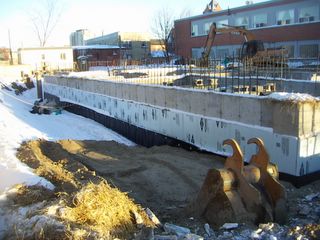Bats expounds on: earth bermed houses
I got a comment from Spider on my blog entry on home energy efficiency; my reply quickly became too large to fit into comments, so I decided to make an independent post of this discussion. She wrote:
Eli and I are slo-oo-owly getting closer to building a house. One of the technical biggies that we're planning on is semi-underground construction. (Our preferred site is backed into a south-facing hillside.) Can you point me at any good references for that sort of construction? We're paranoid about getting it watertight (duh!) and aren't quite sure what the other big bugaboos might be.
-Spider (hoping it's doable after all)
First of all--hi Spider! Hi Eli! Awesome that you're thinking of building from scratch.
Second, I wanted to give the great big caveat that I have no experience with earth bermed construction per se--I've heard plenty about it, but most of the work that I did with my old company was trying to make conventional house construction more energy efficient. I do not have any actual books or authorities to recommend in this field. That being said, there's a lot of the basic science and engineering of below grade structures involved in these bermed houses; my thesis topic is on interior insulation of basement walls, so I have gotten some knowledge of this field inflicted on me.
You are very wise to be very worried about water problems--one of my coworkers stated in regards to the questionable wisdom of finishing basements, "I find it amazing that people will dig a hole in the ground and not expect it to fill with water." His basic conclusion was not that it shouldn't be done--it was that it can be done right, but that it adds time and expense.
On a slightly philosphical side, you shouldn't be thinking in terms of "waterproofing"--remember, submarines are about as waterproof as you get (a few inches of HY80 plate steel), but they still have bilge pumps. Instead, you want to intercept the groundwater coming in, and drain it out before it can do any damage. Running drainpipes to daylight (i.e., make your house high enough in elevation that water drains downhill) is an excellent idea, as opposed to relying on sump pumps. I have not paid the gravity bill in years, and they still haven't shut it off.
The wall system I would recommend is (from inside to outside): your concrete wall, some type of liquid-applied dampproofing (black goopy stuff), insulation (e.g., extruded polystyrene--blue, pink, or green board), and a "dimple mat," which is a plastic product that creates an air space behind it that water can drain down through. My graduate advisor has worked with the company Cosella Dorken; a similar product out there is Platon. I have a sample photo of the apartment building that my advisor is building here in town; it has all of those elements.

As for the roof, there is a lot of technology out there on green roofs, i.e., putting vegetation on the roof to reduce heat gain via plant transpiration and increase insulation--its a hot item among environmental builders. There is developed technology for keeping dirt on the roof but not allowing water through. At the very least, this gives you another term to try Googling. Incidentally, my advisor is doing with his apartment building as well--we got to tour the building the day they were hoisting flats of plant growth medium to the roof.
As further construction notes, the wall insulation should extend all the way down to the bottom. Although there is a pretty small delta T across the bottom of the wall (probably 50 F vs. 70 F inside), most climates have a danger that deep ground temperature (50 F) could be below the dew point temperature of the air in the house. As a result, water could condense on the inside of the concrete walls, possibly damaging the finishes, causing mold, etc. Also, the insulation reduces moisture movement from the soil (along with the dimple mat and the dampproofing)--remember, that deep ground will be around 100% relative humidity year round.
If you are doing radiant floor heating, you need insulation underneath the slab (e.g., 3" of white beadboard expanded polystyrene), as per this report by my advisor and chief grad student.
Don't forget that this house will be quite airtight, having concrete walls on three sides and a concrete ceiling. Therefore, you will need a mechanical ventilation system, as per my original energy efficiency web post.
In terms of web resources on earth bermed houses, one link I found was "The Underground (earth bermed and sheltered) Home Web Site"; unfortunately, it has lots of broken links. But one of the more interesting sites I found through that link was Home Sweet Earth Home.
I also want to perhaps temper your enthusiasm for earth bermed houses with a few thoughts. If you took conventional construction, removed the windows on all sides except for the south, insulated the heck out of the walls and ceiling, and airtightened, you might end up with similar performance to an earth bermed house. I still think its an awesome idea--I'm glad that people are enthusiastic about these high-performing houses, and are willing to put the work into them. But I wanted to point out that there are many facets to improving energy efficiency levels.
Anyway, best of luck with the hobbit hole! (I assume the house will be named 'the Shire' or something similar, right?).


2 Comments:
Yay! Lots and lots of info/pointer. You rock, Bats.
To clarify a little bit...
Our site is near the top of a local maximum - no shortage of gravity there. We're also not planning to sink the entire house into the hill - just the pantry/root cellar/wine cellar room (all hail cool temperature food storage) and the game/library/social room (for escaping into during the hot summer months). The rest of the house will be a bit more "normal." ;)
We are also planning on building an earth-bermed home. Thanks to our plan, I have done extensive research on building materials. You might want to investigate the idea of using 'autoclaved, airiated concrete' instead of regular concrete.It is a lighter,less expensive, and higher quality product that has an extreme fire rating. Just do a search on ACC concrete. There is a lot of information out there. I especially like the Safe-Crete site. Also, I wouldn't get so hung up on the term 'normal'. Underground homes have been in use for thousands of years. All those forbearers can't have been 'abnormal'. Normal is what suit you and your family, what makes you and them happy and content with yourselves and with your home. The ones who continue to live in costly, uncomfortable houses that they are unhappy in and with are the abnormal ones - not us. Good luck with your home.
Post a Comment
<< Home